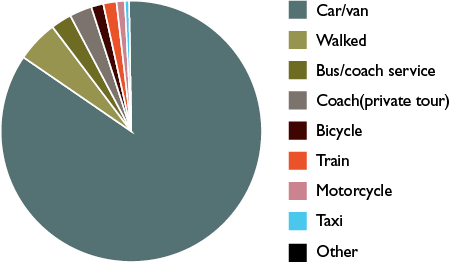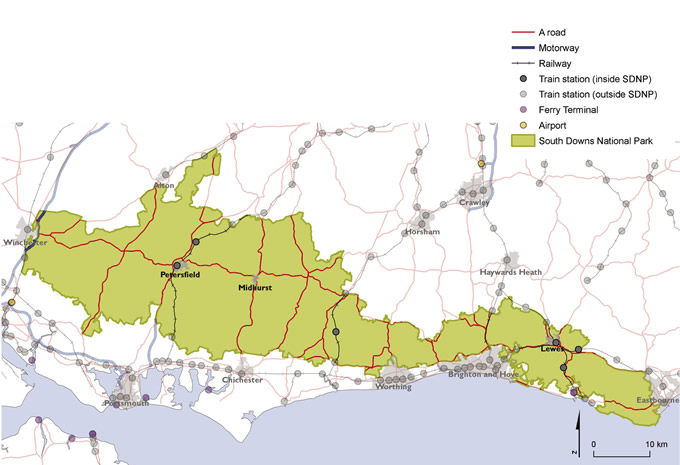For a diagrammatic version of this Fact File |
Transport and travel infrastructure supports access to employment, promotes local business and tourist economies and allows visitors to enjoy the National Park. Adverse impacts of transport can include road traffic congestion, air quality and noise pollution which have a negative impact on the special qualities, the visitors’ experience and quality of life for residents.
Key issues
In 2012 we commissioned an analysis of existing Community Led Plans across the National Park.1 Transport and traffic related issues were identified in more than 78% of existing parish plans. Top issues were:
- Public transport provision – including frequency and destinations of services
- Community transport provision
- Speeding and traffic
- Illegal parking and pressure on car parks
- Impact of HGVs through rural areas
Data and evidence gaps:
In building a transport evidence base for the National Park we will gather a range of data including:
- The extent and usage of public and community transport services
- Percentage of transport accessible for wheelchair users
- Existing and projected traffic flows on identified roads
- Car parking pressures throughout the National Park
- Principle freight movements through the National Park
Transport and travel facts
Travel to work patterns
The National Park is a net importer of labour with around 24,900 commuters coming into the Park and around 22,500 commuting out to various locations mainly within the south east region and London. This is partly explained by urban areas to the South offering potentially cheaper housing than the National Park but also by the presence of Petersfield and Lewes: two main employment hubs within the Park.3
Car travel by residents
Car ownership levels are high with 85% of residents owning at least one car and an estimated 63% of the working population travelling to work by car representing 7.76 million two way journeys annually.
Visitor Travel
In 2003, it was estimated that there were 39 million visitor days spent in the South Downs. The majority of visitor groups: an estimated 84%, travelled by private car.4
Rail Travel
There are 15 rail stations within or close to the National Park boundary but there is little sense of connectivity with the South Downs at stations and information about onward travel in the National Park is not widely available. Some rail commuter routes will be at peak capacity by 2020.5
Transport inequalities
Eastern areas of the National Park are better served by public transport than western areas. The recent cuts in bus subsidies have resulted in reduced services in some areas and a complete cessation of buses in others. Lack of access to public transport results in social exclusion leaving vulnerable groups in rural areas without access to services that are readily available to residents with cars or those living in urban areas. In the same way a lack of public transport can limit opportunities to access natural and green spaces for recreation and healthy exercise.
When passengers on the Breeze up to the Downs Buses were surveyed in 2011, 64% said they were using the bus because they did not have access to a car.2
Sustainable solutions:
Bus and train walks: The SDNPA is promoting 8 walking and 6 cycling routes from bus stops and rail stations, encouraging people to leave their cars at home.
Electric bikes: The South Downs’ first electric bike network has been set up in the National Park with hire points at Alice Holt, Alton, Easebourne and Petersfield.
Breeze up to the Downs: These year round bus services from Brighton and Hove to the popular Devil’s Dyke, Ditchling Beacon and Stanmer Park sites are examples of public transport services aimed specifically at visitors to the countryside. Annual passenger figures for these services are around 84,000. 2
Visitor Travel Modes

Click on the reference number to take you back to your place in the document.
1. SDNPA/Action in rural Sussex & Community Action Hampshire (2012) South Downs National Park: Community Consultation Review 2011–12
2. Brighton and Hove City Council (2012) Breeze up to the Downs Travel Survey Results 2011
3. Hampshire County Council (September 2011) South Downs National Park Local Economy
4. Tourism South East and Geoff Broom Associaties (2004) Visitor Survey of the proposed South Downs National Park 2003–2004, Countryside Agency
5. Network Rail (2010) Sussex Route Utilisation Strategy
